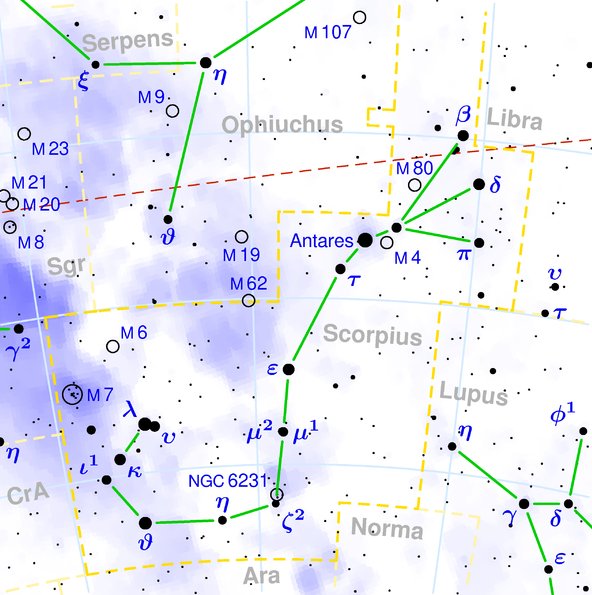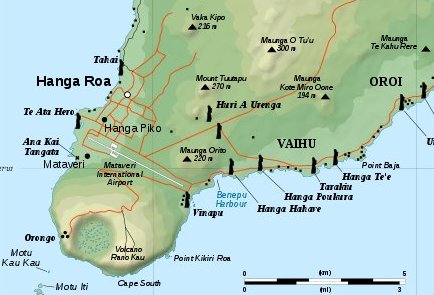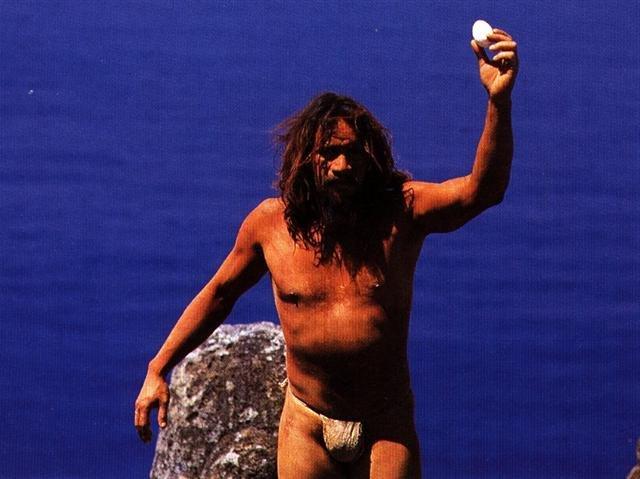Curiosity forced me to take a quick look at the glyphs in the last 5 lines of Aruku Kurenga (B). Although when I was planning my attempt at decoding the glyph texts on the rongorongo tablets I had promised myself to set aside some of them - e.g. B - for other researchers, leaving them without any comments whatsoever. This way my own results would in principle be possible for someone else to test independently. The very last glyph on side a on the B tablet caught my eye. It is basically a kind of mirror form of the poor creature in Gb5-29 (where 52 * 9 = 468), another mutilated creature:
In rongorongo times Gb5-29 was 264 nights after 0h, when the first star in the Sting of the Scorpion (υ, Lesath) was close to the Full Moon.
In B the similar glyph is number 421, and the bird (moa) in Ba10-32 (where 10 * 32 = 320) exhibits a 'headless tail'.
A tail should indicate the last part, especially if there is no head in sight. Manuscript E continues beyond the return of the explorers to Hiva with a strange story about a stone figure named Oto Uta who lost his head. Hotu Matua was the 10th and last of the kings (ariki motogi) and Oto Uta was the 1st (Manuscript E, p. 1):
The structure with 10 kings was probably a heritage from early on: ... Strassmeier and Epping, in their Astronomisches aus Babylon, say that there its [Aries] stars formed the third of the twenty-eight ecliptic constellations, - Arku-sha-rishu-ku, literally the Back of the Head of Ku, - which had been established along that great circle milleniums before our era; and Lenormant quotes, as an individual title from cuneiform inscriptions, Dil-kar, the Proclaimer of Dawn, that Jensen reads As-kar, and others Dil-gan, the Messenger of Light. George Smith inferred from the tablets that it [Hamal] might be the Star of the Flocks; while other Euphratean names have been Lu-lim, or Lu-nit, the Ram's Eye; and Si-mal or Si-mul, the Horn star, which came down even to late astrology as the Ram's Horn. It also was Anuv, and had its constellation's titles I-ku and I-ku-u, - by abbreviation Ku, - the Prince, or the Leading One, the Ram that led the heavenly flock, some of íts titles at a different date being applied to Capella of Auriga. Brown associates it with Aloros, the first of the ten mythical kings of Akkad anterior to the Deluge, the duration of whose reigns proportionately coincided with the distances apart of the ten chief ecliptic stars beginning with Hamal, and he deduces from this kingly title the Assyrian Ailuv, and hence the Hebrew Ayil; the other stars corresponding to the other mythical kings being Alcyone, Aldebaran, Pollux, Regulus, Spica, Antares, Algenib, Deneb Algiedi, and Scheat ... If this ancient structure had been carried along from generation to generation intact through millenia, we could assume the following 10 equations:
However, the 10 Tahitian 'star pillars' (ana) were not the same. Only the first 3 of them in their list had been kept from ancient times. Therefore we cannot so far know if king Oto Uta personified Hamal or if king Hotu.a Matua was Scheat Aquarii. I have Algenib Persei and Algenib Pegasi in my star list, but their right ascension days are not between Antares and Deneb Algiedi. There should be a 3rd 'wing' star somewhere among the constellations, in a place between the Scorpion and the Goat. It could be in Sagittarius (or possibly in the Eagle), and I guess it referred to the vane wing (σ, Nunki) on the arrow of the Archer, hidden in the picture of Hevelius - hidden like the true star name of the 8th mythical king:
The name Taana for the 8th mythical king could have motivated the name 'the 8th island' for Easter Island. Barthel's translation from Manuscript E, pages 12-13: "Hau Maka told about his dream: 'I was sleeping, and this is what happened: My dream soul moved on, and, through the power of her mana, my dream soul reached seven lands, which were lying in the midst of a dim twilight. My dream soul looked around searchingly, but these lands were not very good at all. In the midst of dim twilight there is Te Pei, the residence. Not even eight groups of people (i.e., countless boat crews) can find the small piece (of land?) again once it has been lost. But one (can) take possession of the eighth land: (It lies) 'on high', (it) juts out (on the horizon), and its contours stand out against the (rising) sun (i.e., in the east)." The name of the first kuhane station now seems understandable, it could allude to the 8th mythical king Nunki (Taana): ... Hau Maka had a dream. The dream soul of Hau Maka moved in the direction of the sun (i.e., toward the East). When, through the power of her mana, the dream soul had reached seven lands, she rested there and looked around carefully. The dream soul of Hau Maka said the following: 'As yet, the land that stays in the dim twilight during the fast journey has not been reached.' The dream soul of Hau Maka continued her journey and, thanks to her mana, reached another land. She descended on one of the small islets (off) the coast. The dream soul of Hau Maka looked around and said: 'These are his three young men.' She named the three islets 'the handsome youths of Te Taanga, who are standing in the water' ...
Nunki was the star which defined where the Sea was beginning, the star which stood out in the 'dim twilight' between day (Land) and night (Sea). ... This [σ] has been identified with Nunki of the Euphratean Tablet of the Thirty Stars, the Star of the Proclamation of the Sea, this Sea being the quarter occupied by Aquarius, Capricornus, Delphinus, Pisces, and Pisces Australis. It is the same space in the sky that Aratos designated as Water ... Te Taanga was the father of the 3 islets outside the southwest corner of Easter Island, a place which announced Easter Island lay ahead. The 3 islets stood out against the horizon (te tatanga) for someone approching from the sea.
They were like a horizontal beam in time-space - the islet closest to the island proper was Motu Kau Kau (alias Motu-kaokao).
... On the south-western tip of Easter Island, at Orongo, up near the ragged edge of the Rano Kau crater, are four small holes very precisely pecked through the bedrock just beside a large Ahu. Since Orongo is known to have been an important ritual centre, these holes attracted the attention of the Norwegian Archaeological Expedition which visited the island in 1955-56. They were studied by Dr Edwin Ferdon. After making detailed observations at the solstices and the equinoxes he concluded: 'it can definitely be stated that the complex of four holes constituted a sun-observation device'. As well as one Ahu, Orongo also formerly had one Moai, a unique specimen, carved out of basalt, that was removed to the British Museum in 1868. Perched on a headland with a precipitous drop to the ocean on one side and the gigantic, reed-filled crater of Rano Kau on the other, the main remaining feature of the site is a conglomeration of 54 squat oval houses with massively thick walls of horizontal stone slabs and domed corbel-vaulted ceilings. The ritual that took place in this setting was the annual 'birdman' contest which was held each September - the month of the spring equinox in the southern hemisphere. The origins of this apparently bizarre ceremony are entirely unknown. Its centrepiece was a physical quest for the egg of a sooty tern and specifically for the first tern's egg of the season to be laid on the bird island of Moto-Nui which stands offshore just under a mile to the south-west of the Orongo headland. The quest was undertaken on behalf of noble patrons by young champions called hopu manu ('servants of the bird') and officiated by the learned keepers of the inscribed Rongorongo tablets. On a signal from these scribes the hopu manu clambered down the cliffs of Orongo and paddled themselves out to the island on small conical reed floats called pora. The first to return with a sooty tern's egg would then hand it triumphantly to his patron, who would forthwith be declared the 'Tangatu-Manu' - the sacred 'birdman'. He would be honoured as a king throughout the following year, during which he would shave his head and paint it bright red. At the same time a curious petroglyph of a long-beaked bird-headed man would be carved to represent him on the rocks of Orongo ... |
|||||||||||||||||||||||||||||||||||||||||||||||||||||||||||||||||||||||||||||||||||||||||||||||||||||||||||||||||||||||||||||||||||||||||||||||||||||||||||||||||||||||||||||||||||||||||||||||||||||||||||||||||||||||||||||||||||||||||||||||||||||||||||||||||||||||||||||||||||











